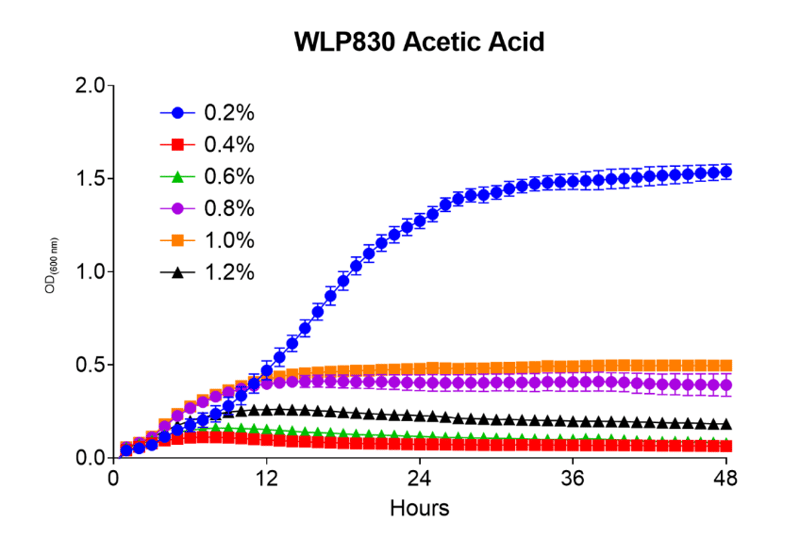Brewers regularly produce wort with varying strengths and chemical properties. Most brewing strains have evolved to thrive within a narrow range of growth conditions specific to certain styles. As brewers, we already choose strain parameters depending on the yeast strain, from attenuation ranges, flocculation characteristics, and preferred fermentation temperatures.
By characterizing the tolerance of White Lab's strains to key stresses in brewing wort, such as osmotic and organic acid stress, we can identify the best strains for each application and determine which strains have the broadest range of applications.
Osmotic stress occurs when there is a difference in concentrations between the inside and outside of the cell. This can occur from differences in minerals as well as densities, such as high-gravity beers.
Organic Acids can also produce stress to yeast at high concentrations. Yeast naturally produces organic acids, as they create a favorable environment for themselves in fermentation. Lactic acid is the main organic acid found in beer, while higher concentrations of Lactic or Acetic can be found in sour beers.
Naturally, strains and humans alike do not like to be stressed. Stress can lead to incomplete and stalled fermentations or other fermentation problems and off-flavors being produced. The top-selling strains were evaluated for their tolerance to high gravity or high acid concentration using our high-throughput platform to help find more robust strains capable of fermenting under stress.
R&D Blog Experiment: WLP655 Belgian Sour Mix 1 Over Time - Organic Acid-Related
Blog: WLP808 Mythical Hammer Lager Yeast Blend - Pressurized Stress-Related
Experiment
Pitch Rate: 7.5 million/mL
Temperature: 77 °F/ 25 °C
Scale of propagation: 48 well plate
For assessing the osmotic stress tolerance, the strains were tested in wort prepared from DME at:
10 °P, 15 °P, 20 °P, & 25 °P
The wort was autoclaved and used in the plate reader tests.
For assessing the organic acid stress tolerance, the strains will be tested in wort-prepared from DME at 10 °P
The wort was spiked with Lactic or Acetic acid at
0.2% (v/v); 0.4% (v/v); 0.6% (v/v), 0.8% (v/v); 1.0% (v/v), & 1.2% (v/v))
Results
- The top-selling strains exhibited varying tolerance levels to the tested stressor conditions (Fig.1). For osmotic stress, high gravity conditions above > 20 P reduced yeast growth.
- Acetic acid emerged as the most potent stressor for the strains tested, significantly inhibiting growth above 0.2% v/v.
- Conversely, most strains were able to grow in lactic acid concentrations up to 1.2% v/v.
- WLP830 German Lager Yeast demonstrated the highest tolerance to acetic acid (Fig. 2), while WLP002 English Ale Yeast showed the greatest sensitivity to lactic acid (Fig. 3).
 Figure 1. Heat map illustrating the growth of yeast in the presence of various stressors: gravity, lactic acid, and acetic acid.
Figure 1. Heat map illustrating the growth of yeast in the presence of various stressors: gravity, lactic acid, and acetic acid.
The color gradient represents the extent of yeast growth (Red indicates maximum yeast growth; Beige indicates moderate yeast growth; White indicates no yeast growth)

Figure 2. Growth curves of WLP830 in the presence of acetic acid. WLP830 still grows under 0.2% Acetic Acid Concentrations
 Figure 3. Growth curves of WLP002 in the presence of lactic acid. WLP002 grows well even up to 1.2% concentration of lactic acid.
Figure 3. Growth curves of WLP002 in the presence of lactic acid. WLP002 grows well even up to 1.2% concentration of lactic acid.
Conclusions
The strains exhibit a unique tolerance profile to common stressors found in brewing wort. By screening each strain for tolerance to various stressors, we can identify potential new applications or brewing styles for each strain.
These profiles suggest that certain strains are particularly suitable for fermenting lactic acid-rich kettle sours. Additionally, considering their alcohol tolerance, some strains could serve effectively as bottling strains for beers or alcoholic beverages with low pH or high ethanol content. Strains with high acetic acid tolerance might even be used as the primary fermenting strain in kombucha blends.
Expanding this screening to include more strains in our collection may reveal strains with untapped potential for specific applications.








